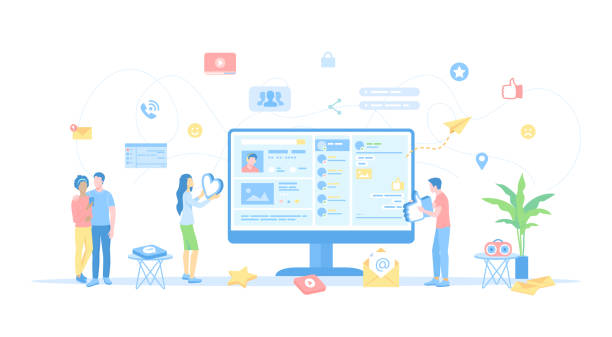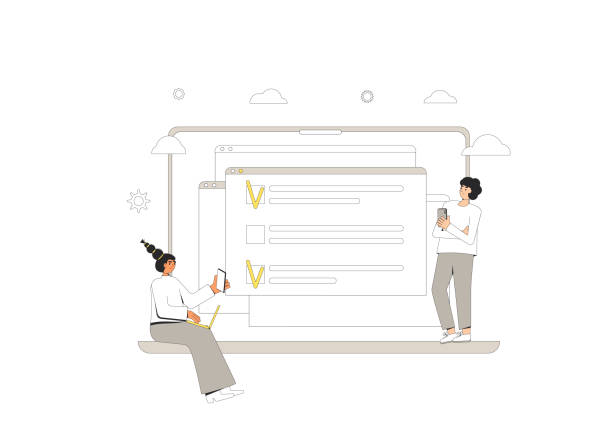Introduction to the Importance of Secure Website Design

In today’s digital world, where information is moving at an unprecedented speed, #website_security has become more vital than ever.
Users and businesses are increasingly dependent on online platforms, and this dependency doubles the importance of #data_protection.
#Secure_website_design is not just a technical requirement, but an investment in maintaining #user_trust and brand reputation.
Without adhering to security principles, websites become easy targets for #cyber_attacks that can lead to the loss of sensitive information, financial damages, and irreparable harm to reputation.
This chapter analyzes the main reasons for the importance of secure website design and demonstrates why every business, regardless of size and field of activity, should prioritize security in its web development plans.
Our discussion begins with an overview of today’s security challenges and then moves on to how a proactive approach can make a significant difference in the stability and success of a website.
The main goal of this section is to raise public awareness about the necessity of website security and to encourage the implementation of security standards from the very early stages of development.
Do you know that the first impression customers have of your company is your website? With a powerful corporate website from Rasaweb, multiply your business’s credibility!
✅ Custom and eye-catching design tailored to your brand
✅ Improved user experience and increased customer acquisition
⚡ Get a free consultation!
Common Web Security Threats and How to Identify Them

Knowing the enemy is the first step in defense.
To achieve secure website design, it is essential to be familiar with the most common security threats targeting websites.
This section specifically examines various types of cyberattacks; from SQL injection and cross-site scripting (XSS), which exploit programming vulnerabilities, to distributed denial-of-service (DDoS) attacks that disable websites with high traffic volumes.
We also cover phishing and social engineering attacks that target users, and malware and ransomware that encrypt or steal information.
How can these threats be identified? Vulnerability scanners and intrusion detection systems (IDS) play a key role in early threat detection.
Furthermore, continuous training of the development team on secure coding best practices and the implementation of regular security audits are an integral part of a secure website building strategy.
By deeply understanding these threats, we can adopt more effective preventive measures in the secure website design process and protect our website from potential attacks.
Basic Principles of Web Security and Security Architecture

To achieve secure website design, adhering to basic web security principles and designing a robust security architecture are essential.
This section, as a tutorial and guide, explains the foundation of any web security project.
Security architecture should be considered from the very initial stages of system design, rather than being added as an extra component after development is complete.
The first principle is “Security by Design” (Security by Design), which means embedding security considerations into every layer of web development, from the database to the user interface.
The second principle is “Least Privilege” (Least Privilege), which grants users and systems only the minimum access necessary to perform their tasks.
This is particularly crucial in the context of access management for users and services.
The third principle is “Defense in Depth” (Defense in Depth), meaning that multiple independent security layers should exist so that even if one layer fails, subsequent layers can protect the system.
The following table presents some key principles of security architecture:
| Principle | Description | Importance in Secure Website Design |
|---|---|---|
| Security by Design | Embedding security considerations from the outset of the development lifecycle. | Reducing security costs and early detection of vulnerabilities. |
| Least Privilege | Granting the minimum necessary access to users and systems. | Limiting the scope of damage in case of a security breach. |
| Defense in Depth | Utilizing multiple independent security layers. | Increasing system resilience against attacks. |
| Separation of Duties | Separating critical tasks among different individuals or systems. | Preventing accumulation of power and reducing fraud risk. |
Furthermore, the use of Web Application Firewalls (WAFs), secure Content Management Systems (CMS), and regular software updates are part of this architecture.
Web design with a security-first approach requires strategic thinking and integrating security at every step of development.
Choosing Secure Technologies and Encryption Protocols

On the path to secure website design, choosing appropriate technologies and utilizing advanced encryption protocols are of paramount importance.
This section specifically and descriptively addresses this crucial aspect.
The first step is to choose a programming language and framework with a strong security track record.
Languages such as Python, Java, and C#, along with reputable frameworks, offer built-in security tools and capabilities that can contribute to secure web development.
The use of HTTPS protocol with an SSL/TLS certificate is an undeniable necessity today.
HTTPS encrypts all communications between the user’s browser and the web server, preventing eavesdropping, tampering, or forging of data.
Ensuring correct SSL/TLS configuration and using newer versions of the protocol, such as TLS 1.2 or 1.3, is crucial.
For databases as well, using reputable Database Management Systems (DBMS) with built-in security features such as encryption at rest and encryption in transit, and also precise access control, is recommended.
Furthermore, implementing strong encryption mechanisms for passwords (such as salted hashing) and other sensitive user information is a fundamental principle of website hardening.
Choosing security monitoring tools and intrusion detection/prevention systems (IDS/IPS) also helps enhance overall security.
This comprehensive approach to technology selection and implementation forms the foundation of a sustainable and resilient secure website design.
Are you dissatisfied with the low sales of your online store?
Rasaweb is your solution for having a professional and high-selling online store.
✅ Significant increase in sales and revenue
✅ Easy and enjoyable shopping experience for customers
⚡ Get a free consultation from Rasaweb now!
Implementing Strong Authentication and Access Management

One of the main pillars of secure website design is the implementation of powerful authentication and access management (IAM) systems.
This section addresses this topic as a guide and specialized content.
Strong authentication is the first line of defense against unauthorized access.
The use of complex passwords, regular password change policies, and especially two-factor authentication (2FA) or multi-factor authentication (MFA) is strongly recommended.
2FA adds an extra layer of security that protects the user account even if the password is compromised.
The Access Control system also determines which resources users can access and with what level of permissions after authentication.
Implementing Role-Based Access Control (RBAC) or Attribute-Based Access Control (ABAC) models can reduce the complexity of access management and enhance security.
The importance of granting the minimum necessary access to each user or service should not be underestimated. This “least privilege” principle prevents damage propagation in case of a security breach.
Furthermore, implementing Single Sign-On (SSO) systems for large websites with multiple sections or services can improve user experience while increasing security through centralized identity management.
Continuous monitoring of authentication and access logs is also essential for identifying suspicious patterns and intrusion attempts.
These collective measures form the foundation of a secure online platform and significantly contribute to achieving the goals of secure website design.
Penetration Testing and Vulnerability Assessment

After the initial implementation of secure website design, the next crucial step is continuous security testing and evaluation.
This section addresses penetration testing and vulnerability assessment in a specialized and engaging manner.
Penetration testing is a simulated and controlled cyberattack performed by security experts (ethical hackers) to find weaknesses and vulnerabilities in systems and web applications.
This process can be very exciting; like a puzzle game where experts try to find security gaps before hackers do! These tests are conducted regularly and systematically, covering all security aspects, including server configuration, application code, database, and networks.
Vulnerability Assessment also involves using automated and manual tools to identify known vulnerabilities.
These tools can quickly provide a list of potential weaknesses that then need to be verified and remediated by experts.
Finding a security bug before it is discovered by a real attacker can save your website’s life. Reports from penetration testing and vulnerability assessments provide a roadmap for continuous improvement of website security.
These reports include details of vulnerabilities, their risk level, and suggested remediation strategies.
This iterative and continuous process is an integral part of the secure website design lifecycle and ensures that your website remains resilient against new threats.
One should never assume that security is a one-time project; rather, it is an ongoing process.
Backup and Data Recovery in the Face of Attacks

Even with the best secure website design and strongest preventive measures, the risk of a cyberattack or system failure never reaches zero.
Therefore, planning for disaster recovery and data restoration is of vital importance.
This section addresses the topic of backup and data recovery as a guide and news content.
Having a comprehensive Backup Strategy for all critical website data, including code, database, and configuration files, is an absolute necessity.
These backups should be performed regularly and automatically and stored in secure, preferably separate locations (offline or in secure cloud storage).
The ability to quickly and completely restore data after a security incident or system failure can be the difference between bankruptcy and the survival of a business. Database management systems, such as MySQL or PostgreSQL, offer tools for rapid backup.
The good news is that many web hosting providers also offer automatic backup services, but it is always recommended that businesses also maintain their independent backup copies.
Furthermore, having a Disaster Recovery Plan (DRP) that includes detailed steps for restoring systems and data in the event of a major incident is strongly recommended.
This plan should be regularly tested to ensure its effectiveness.
The following table outlines different types of backups and their characteristics:
| Backup Type | Description | Advantages | Disadvantages |
|---|---|---|---|
| Full | Backup of all data. | Simplest and fastest recovery. | Requires large storage space and long time. |
| Incremental | Only data changed since the last backup (full or incremental). | Less time, less space. | More complex and slower recovery. |
| Differential | Only data changed since the last full backup. | Faster recovery than incremental, moderate space. | More space than incremental. |
Ensuring a robust plan for online platform protection against data loss is an integral part of secure website design.
User Training and the Importance of Human Security

In any secure website design strategy, the human factor plays a pivotal role.
This section, as educational and thought-provoking content, addresses the importance of training users and the internal team in maintaining security.
Did you know that over 90% of successful cyberattacks occur due to human errors? This startling statistic shows that even with the implementation of the strongest security technologies, if users are not adequately trained, your website will remain vulnerable.
User training includes topics such as: identifying phishing emails, the importance of using strong and unique passwords, how to handle sensitive information, and recognizing suspicious behaviors.
But the main question is: how can these trainings be made effective and engaging? Traditional training methods might be boring.
New approaches such as interactive trainings, phishing attack simulations (in controlled environments), and practical workshops can be used.
Fostering a culture of security within the organization is also of high importance; security should be considered a shared responsibility, not just the IT department’s duty.
The question is whether companies invest enough in training their human resources? Many security breaches result from employee carelessness or lack of awareness.
Therefore, continuous training and updating users’ security knowledge are as vital as updating security software.
This aspect of website hardening is often overlooked, yet it is one of the most cost-effective and efficient ways to strengthen overall security.
Remember that the most secure system is only as secure as its weakest human link.
Are you dissatisfied with the low sales of your online store?
Rasaweb is your solution for having a professional and high-selling online store.
✅ Significant increase in sales and revenue
✅ Easy and enjoyable shopping experience for customers
⚡ Get a free consultation from Rasaweb now!
Continuous Updates and Website Security Maintenance

Secure website design is not a static process, but requires continuous maintenance and updates.
This section descriptively and specifically addresses the importance of this vital aspect.
Cyber threats are constantly evolving and becoming more complex, and new vulnerabilities are regularly discovered.
Therefore, to maintain website security, one must always stay ahead of attackers.
This means that all software used on the website, from the server operating system to the Content Management System (CMS), plugins, themes, and code libraries, must be regularly and timely updated.
Ignoring updates opens the door for cyber attackers. Many successful attacks exploit known vulnerabilities for which security patches have been released but not installed by website administrators.
In addition to updates, continuous monitoring of website activities through logs and security monitoring systems is also essential.
Identifying abnormal traffic patterns, unsuccessful login attempts, or suspicious file activities can be an indication of an ongoing attack.
Proper configuration of the server and web software should also be periodically reviewed to ensure that no insecure default settings exist.
Regular execution of security scans and penetration tests, as mentioned in previous sections, is also part of continuous maintenance.
Given the rapid changes in the cybersecurity domain, security protocols and implementation methods should also be regularly reviewed to ensure compliance with the latest standards.
This proactive and continuous approach will ensure secure website design in the long run.
The Future of Secure Website Design and Emerging Trends

As technology advances, the challenges of secure website design also evolve.
This section analytically and informatively examines emerging trends in web security.
One of the most important future trends is the increasing role of Artificial Intelligence (AI) and Machine Learning (ML) in cybersecurity. AI/ML can identify complex attack patterns that are impossible for humans and also automatically respond to threats.
These technologies will play a vital role in future intrusion detection systems (IDS) and intrusion prevention systems (IPS).
On the other hand, with the expansion of the Internet of Things (IoT) and communication between various devices, new entry points for attackers are created, posing new challenges for website hardening and its related ecosystems.
API (Application Programming Interfaces) security is also becoming a very important area, as many modern web applications heavily rely on APIs for communication with other services.
Threats from Supply Chain attacks, which target software and libraries used in development, are also increasing and require new security approaches in secure web development.
The emergence of quantum computing has also raised concerns about the breaking of current encryption algorithms, necessitating the development of “quantum-resistant” cryptography.
Secure website design in the future will increasingly rely on integration, automation, and intelligence in identifying and responding to threats.
Preparedness for these changes and investment in emerging security technologies are crucial for maintaining the stability and security of websites in the coming decade.
Frequently Asked Questions
| Question | Answer |
|---|---|
| 1. What does secure website design mean? | Secure website design means creating a website that is resistant to cyberattacks and protects user and server information. |
| 2. Why is security important in website design? | To prevent data breaches, maintain user privacy, preserve user trust, and avoid financial and reputational losses. |
| 3. What are the most common web vulnerabilities? | SQL Injection, Cross-Site Scripting (XSS), Cross-Site Request Forgery (CSRF), Broken Authentication, and Security Misconfiguration. |
| 4. How can SQL Injection be prevented? | By using Prepared Statements / Parameterized Queries, ORMs, and Input Validation. |
| 5. What is the role of HTTPS and SSL/TLS in website security? | HTTPS uses the SSL/TLS protocol to encrypt communication between the user’s browser and the server, preventing eavesdropping and data tampering. |
| 6. What measures should be taken to prevent XSS attacks? | Input validation, Output Encoding to prevent malicious code execution, and using Content Security Policy (CSP). |
| 7. What does a strong password policy include? | Enforcing the use of long passwords, a combination of uppercase and lowercase letters, numbers, and special characters, and preventing reuse. |
| 8. How does two-factor authentication (2FA) help with security? | Even if the user’s password is compromised, the attacker cannot access the account without access to the second authentication factor (such as an SMS code or an app). |
| 9. What is a Web Application Firewall (WAF) and what is its use? | A WAF is a firewall that monitors and filters HTTP traffic between a web application and the internet to prevent common web attacks such as SQL injection and XSS. |
| 10. Why are regular updates of software and libraries important? | Updates often include security patches to fix discovered vulnerabilities. Failure to update can expose the site to new attacks. |
And other services of Rasaweb Advertising Agency in the field of advertising
Smart Marketing Automation: Designed for businesses seeking online growth through precise audience targeting.
Smart Sales Automation: An effective tool for increasing click-through rates with the help of attractive UI design.
Smart Google Ads: An effective tool for improving SEO ranking with the help of SEO-driven content strategy.
Smart Marketplace: A professional solution for improving SEO ranking with a focus on customizing user experience.
Smart Digital Branding: Designed for businesses seeking digital branding through intelligent data analysis.
And over a hundred other services in the field of internet advertising, advertising consultation, and organizational solutions
Internet Advertising | Advertising Strategy | Advertorial
Resources
Comprehensive Website Security Guide
Data Protection on Websites
Website Design Security Tips
Principles of Secure Web Design
? To make your business seen and thrive in the digital world, Rasaweb Afarin Digital Marketing Agency, with expertise in areas such as personal website design, SEO, and online advertising campaign management, is your partner to make your brand shine.
📍 Tehran, Mirdamad Street, next to Bank Markazi, Southern Kazeroon Alley, Ramin Alley, No. 6



